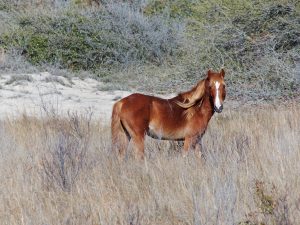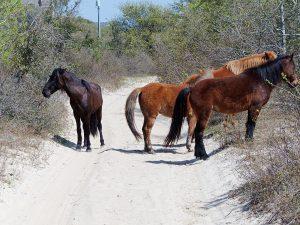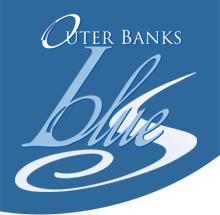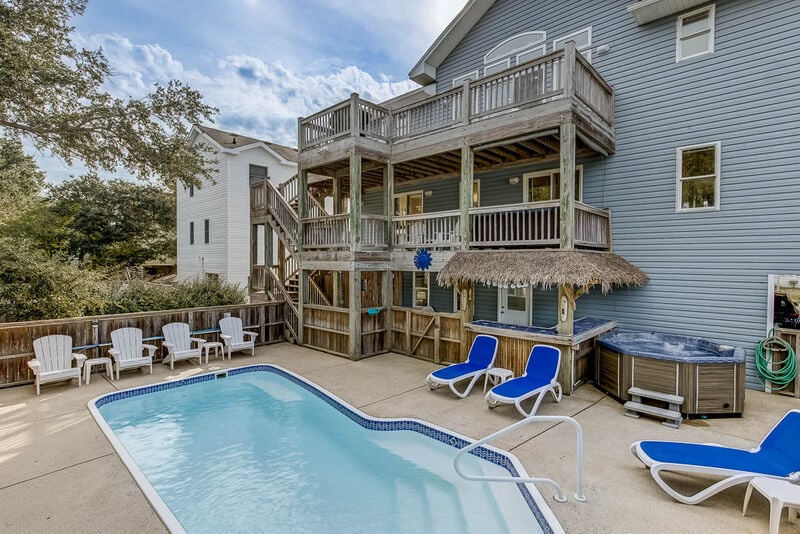
Summer has settled over the Outer Banks and a little past where the paved road ends in Corolla, the heat of the day is settling in. It promises to be a great beach day, warm temperatures, the ocean cool—but not too cold, and the surf rolling in with one and two foot waves. Families are on the beach enjoying the day...and not just human families. A stallion and his harem—three mares and a colt—are playing in the surf. No one is quite sure why the Corolla Wild Horses seem to enjoy the surf so much, but the most reasonable explanation is for the same reason that people enjoy the beach—it's a great way to cool off.Farther up the shoreline four horses are in silhouette on a dune, grazing on the seagrass that covers it. They will eat only the top part of the grass, unlike a domestic horse in a pasture who will forage to bare ground. It is behavior that only the Banker horses exhibit—perhaps they don't like the sand in their diet or the taste of the seagrass isn't as good closer to the roots—but the phenomenon is well-documented.The Corolla Wild Horses are feral animals, not truly wild for they are not native to this area. Watching them in this environment, though, they seem a natural part of the landscape—majestic, beautiful and timeless.They are a distinctive breed; 450 years of isolation has created a horse that is truly unique to the Outer Banks.

The Corolla horses are not large horses, the smaller ones barely bigger than some ponies. Physically they tend to be somewhat short and stocky with narrow but deep chests. Their backs are shorter in comparison to their body than most other breeds and the tail tends to sit low on their body. Most of the Corolla horses have five lumbar (lower) vertebrae, one less than most breeds of horse. That, however, is not considered a determining factor. Other breeds of horses sometimes have five lumbar and occasionally a Corolla horse will have six.There is much that is not known about the Corolla Wild Horses, but in the past few years, some answers have emerged, but with those answers the riddle of how they came to live in Corolla has deepened.Genetic testing and examination by experts have established the Corolla Wild Horses are direct descendents of the Spanish Mustangs of the Conquistadores. The only other wild herd that shares as many genetic characteristics as they do to the original Spanish Mustangs is the Shackleford Banks herd managed by the National Park Service.There is a mystery in that, though. If the Corolla Wild Horses are the closest relative to the Spanish Mustangs of yore, how did they get to the Outer Banks?Figuring that out will take a quick dive into history and some guesswork based on things we do know.The popular theory that the horses came from a shipwreck probably didn't happen. The problem is how horses were transported in the 16th century.Concerned that the motion of the ship would break their legs, horses were suspended below deck in harnesses. For a horse to have escaped a sinking ship, a crew member would have had to abandon whatever their task was as the ship was being pummeled by the sea, release the animal and probably open some door somewhere for it to escape. Not very likely.There were other ways for the horses to have gotten to the Outer Banks.Within 10 years of Columbus returning to Europe with news of the New World, Spanish horse breeding operations were well-established throughout the Caribbean.As the Spanish began to explore the coast of what is now the southeastern coast of the United States, they attempted a number colonies. St. Augustine, Florida is recognized as the oldest European town in the United States, but only because it was the last of a series of unsuccessful attempts.The colonies failed for a number of reasons: illness, weather, Native American anger with the Spanish—they took a dim view of the Spanish custom of enslaving captives. All colonies had livestock, including horses, and it is unlikely the horses would have been loaded on to ships when evacuating a colony.In support of that theory, there are pockets of feral or wild horse in South Carolina and Florida that are recognized as genetically linked to the Colonial Spanish Mustangs.It is possible that the horses migrated north from the unsuccessful colonies in Florida and South Carolina. Although small in stature, the Spanish Mustang was noted for its intelligence, stamina and determination, so it would be feasible for them to make the journey.There is another theory that is intriguing and worth considering—did the Corolla Wild Horse herd first come to the Outer Banks with the Lost Colony?On his way to the Roanoke Colony in 1585, Sir Richard Grenville, the leader of the expedition, stopped in the West Indies to buy livestock, including stallions and mares.As the fleet neared Roanoke Inlet from the south, Grenville's flagship, the Tiger, ran aground. There is some debate if the ship ran aground at what is now Ocracoke Island or farther north, possibly around Buxton. What is known, is the ship, which was carrying most of the supplies for the colony, had to jettison almost all of its cargo, including the livestock.Ocracoke and Hatteras were connected at that time and there were no inlets heading north until the now closed Roanoke Inlet at what is now Nags Head. Oregon Inlet did not open until 1846 in the same hurricane that opened Hatteras Inlet.The jettisoned horses could only have migrated north; the only permanent inlet along the Outer Banks is Ocracoke Inlet separating Ocracoke from Portsmouth Island.It's an interesting theory and it seems as likely as any other.All the theories about how the Corolla Wild Horses came to the to the Outer Banks have questions with them, but what is known, is that by the early 1700s when European settlers once again came to the Outer Banks, the Banker horses were well-established.
 Summer has settled over the Outer Banks and a little past where the paved road ends in Corolla, the heat of the day is settling in. It promises to be a great beach day, warm temperatures, the ocean cool—but not too cold, and the surf rolling in with one and two foot waves. Families are on the beach enjoying the day...and not just human families. A stallion and his harem—three mares and a colt—are playing in the surf. No one is quite sure why the Corolla Wild Horses seem to enjoy the surf so much, but the most reasonable explanation is for the same reason that people enjoy the beach—it's a great way to cool off.Farther up the shoreline four horses are in silhouette on a dune, grazing on the seagrass that covers it. They will eat only the top part of the grass, unlike a domestic horse in a pasture who will forage to bare ground. It is behavior that only the Banker horses exhibit—perhaps they don't like the sand in their diet or the taste of the seagrass isn't as good closer to the roots—but the phenomenon is well-documented.The Corolla Wild Horses are feral animals, not truly wild for they are not native to this area. Watching them in this environment, though, they seem a natural part of the landscape—majestic, beautiful and timeless.They are a distinctive breed; 450 years of isolation has created a horse that is truly unique to the Outer Banks.
Summer has settled over the Outer Banks and a little past where the paved road ends in Corolla, the heat of the day is settling in. It promises to be a great beach day, warm temperatures, the ocean cool—but not too cold, and the surf rolling in with one and two foot waves. Families are on the beach enjoying the day...and not just human families. A stallion and his harem—three mares and a colt—are playing in the surf. No one is quite sure why the Corolla Wild Horses seem to enjoy the surf so much, but the most reasonable explanation is for the same reason that people enjoy the beach—it's a great way to cool off.Farther up the shoreline four horses are in silhouette on a dune, grazing on the seagrass that covers it. They will eat only the top part of the grass, unlike a domestic horse in a pasture who will forage to bare ground. It is behavior that only the Banker horses exhibit—perhaps they don't like the sand in their diet or the taste of the seagrass isn't as good closer to the roots—but the phenomenon is well-documented.The Corolla Wild Horses are feral animals, not truly wild for they are not native to this area. Watching them in this environment, though, they seem a natural part of the landscape—majestic, beautiful and timeless.They are a distinctive breed; 450 years of isolation has created a horse that is truly unique to the Outer Banks. The Corolla horses are not large horses, the smaller ones barely bigger than some ponies. Physically they tend to be somewhat short and stocky with narrow but deep chests. Their backs are shorter in comparison to their body than most other breeds and the tail tends to sit low on their body. Most of the Corolla horses have five lumbar (lower) vertebrae, one less than most breeds of horse. That, however, is not considered a determining factor. Other breeds of horses sometimes have five lumbar and occasionally a Corolla horse will have six.There is much that is not known about the Corolla Wild Horses, but in the past few years, some answers have emerged, but with those answers the riddle of how they came to live in Corolla has deepened.Genetic testing and examination by experts have established the Corolla Wild Horses are direct descendents of the Spanish Mustangs of the Conquistadores. The only other wild herd that shares as many genetic characteristics as they do to the original Spanish Mustangs is the Shackleford Banks herd managed by the National Park Service.There is a mystery in that, though. If the Corolla Wild Horses are the closest relative to the Spanish Mustangs of yore, how did they get to the Outer Banks?Figuring that out will take a quick dive into history and some guesswork based on things we do know.The popular theory that the horses came from a shipwreck probably didn't happen. The problem is how horses were transported in the 16th century.Concerned that the motion of the ship would break their legs, horses were suspended below deck in harnesses. For a horse to have escaped a sinking ship, a crew member would have had to abandon whatever their task was as the ship was being pummeled by the sea, release the animal and probably open some door somewhere for it to escape. Not very likely.There were other ways for the horses to have gotten to the Outer Banks.Within 10 years of Columbus returning to Europe with news of the New World, Spanish horse breeding operations were well-established throughout the Caribbean.As the Spanish began to explore the coast of what is now the southeastern coast of the United States, they attempted a number colonies. St. Augustine, Florida is recognized as the oldest European town in the United States, but only because it was the last of a series of unsuccessful attempts.The colonies failed for a number of reasons: illness, weather, Native American anger with the Spanish—they took a dim view of the Spanish custom of enslaving captives. All colonies had livestock, including horses, and it is unlikely the horses would have been loaded on to ships when evacuating a colony.In support of that theory, there are pockets of feral or wild horse in South Carolina and Florida that are recognized as genetically linked to the Colonial Spanish Mustangs.It is possible that the horses migrated north from the unsuccessful colonies in Florida and South Carolina. Although small in stature, the Spanish Mustang was noted for its intelligence, stamina and determination, so it would be feasible for them to make the journey.There is another theory that is intriguing and worth considering—did the Corolla Wild Horse herd first come to the Outer Banks with the Lost Colony?On his way to the Roanoke Colony in 1585, Sir Richard Grenville, the leader of the expedition, stopped in the West Indies to buy livestock, including stallions and mares.As the fleet neared Roanoke Inlet from the south, Grenville's flagship, the Tiger, ran aground. There is some debate if the ship ran aground at what is now Ocracoke Island or farther north, possibly around Buxton. What is known, is the ship, which was carrying most of the supplies for the colony, had to jettison almost all of its cargo, including the livestock.Ocracoke and Hatteras were connected at that time and there were no inlets heading north until the now closed Roanoke Inlet at what is now Nags Head. Oregon Inlet did not open until 1846 in the same hurricane that opened Hatteras Inlet.The jettisoned horses could only have migrated north; the only permanent inlet along the Outer Banks is Ocracoke Inlet separating Ocracoke from Portsmouth Island.It's an interesting theory and it seems as likely as any other.All the theories about how the Corolla Wild Horses came to the to the Outer Banks have questions with them, but what is known, is that by the early 1700s when European settlers once again came to the Outer Banks, the Banker horses were well-established.
The Corolla horses are not large horses, the smaller ones barely bigger than some ponies. Physically they tend to be somewhat short and stocky with narrow but deep chests. Their backs are shorter in comparison to their body than most other breeds and the tail tends to sit low on their body. Most of the Corolla horses have five lumbar (lower) vertebrae, one less than most breeds of horse. That, however, is not considered a determining factor. Other breeds of horses sometimes have five lumbar and occasionally a Corolla horse will have six.There is much that is not known about the Corolla Wild Horses, but in the past few years, some answers have emerged, but with those answers the riddle of how they came to live in Corolla has deepened.Genetic testing and examination by experts have established the Corolla Wild Horses are direct descendents of the Spanish Mustangs of the Conquistadores. The only other wild herd that shares as many genetic characteristics as they do to the original Spanish Mustangs is the Shackleford Banks herd managed by the National Park Service.There is a mystery in that, though. If the Corolla Wild Horses are the closest relative to the Spanish Mustangs of yore, how did they get to the Outer Banks?Figuring that out will take a quick dive into history and some guesswork based on things we do know.The popular theory that the horses came from a shipwreck probably didn't happen. The problem is how horses were transported in the 16th century.Concerned that the motion of the ship would break their legs, horses were suspended below deck in harnesses. For a horse to have escaped a sinking ship, a crew member would have had to abandon whatever their task was as the ship was being pummeled by the sea, release the animal and probably open some door somewhere for it to escape. Not very likely.There were other ways for the horses to have gotten to the Outer Banks.Within 10 years of Columbus returning to Europe with news of the New World, Spanish horse breeding operations were well-established throughout the Caribbean.As the Spanish began to explore the coast of what is now the southeastern coast of the United States, they attempted a number colonies. St. Augustine, Florida is recognized as the oldest European town in the United States, but only because it was the last of a series of unsuccessful attempts.The colonies failed for a number of reasons: illness, weather, Native American anger with the Spanish—they took a dim view of the Spanish custom of enslaving captives. All colonies had livestock, including horses, and it is unlikely the horses would have been loaded on to ships when evacuating a colony.In support of that theory, there are pockets of feral or wild horse in South Carolina and Florida that are recognized as genetically linked to the Colonial Spanish Mustangs.It is possible that the horses migrated north from the unsuccessful colonies in Florida and South Carolina. Although small in stature, the Spanish Mustang was noted for its intelligence, stamina and determination, so it would be feasible for them to make the journey.There is another theory that is intriguing and worth considering—did the Corolla Wild Horse herd first come to the Outer Banks with the Lost Colony?On his way to the Roanoke Colony in 1585, Sir Richard Grenville, the leader of the expedition, stopped in the West Indies to buy livestock, including stallions and mares.As the fleet neared Roanoke Inlet from the south, Grenville's flagship, the Tiger, ran aground. There is some debate if the ship ran aground at what is now Ocracoke Island or farther north, possibly around Buxton. What is known, is the ship, which was carrying most of the supplies for the colony, had to jettison almost all of its cargo, including the livestock.Ocracoke and Hatteras were connected at that time and there were no inlets heading north until the now closed Roanoke Inlet at what is now Nags Head. Oregon Inlet did not open until 1846 in the same hurricane that opened Hatteras Inlet.The jettisoned horses could only have migrated north; the only permanent inlet along the Outer Banks is Ocracoke Inlet separating Ocracoke from Portsmouth Island.It's an interesting theory and it seems as likely as any other.All the theories about how the Corolla Wild Horses came to the to the Outer Banks have questions with them, but what is known, is that by the early 1700s when European settlers once again came to the Outer Banks, the Banker horses were well-established.





